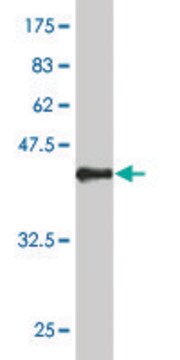AB1854
Anti-Bone Sialoprotein II Antibody
serum, Chemicon®
Synonym(s):
BSPII, Integrin-binding Sialoprotein
About This Item
Recommended Products
biological source
rabbit
Quality Level
antibody form
serum
antibody product type
primary antibodies
clone
polyclonal
species reactivity
rat, human
manufacturer/tradename
Chemicon®
technique(s)
ELISA: suitable
immunocytochemistry: suitable
immunohistochemistry (formalin-fixed, paraffin-embedded sections): suitable
radioimmunoassay: suitable
western blot: suitable
NCBI accession no.
UniProt accession no.
shipped in
wet ice
target post-translational modification
unmodified
Gene Information
human ... IBSP(3381)
rat ... Ibsp(24477)
General description
Specificity
Application
Immunohistochemistry (Paraffin) (see suggested protocol below)
Immunocytochemistry (1:100)
RIA
ELISA
Optimal working dilutions must be determined by the end user.
SUGGESTED STAINING PROCEDURE FOR RABBIT ANTI-BONE SIALOPROTEINAB1854
This protocol has been used successfully on 5 um, paraffin embedded sections from human fetal tibia, human fetal calvaria, human metastatic breast tumors to bone which were decalcified in 10% formic acid.
1. Dewaxing: Xylene 5 min. - Xylene 5 min. - Xylene 5 min.
2. Rehydration: 100% ethanol for 3 min. - 95% ethanol for 3 min. - 70% ethanol for 3 min.
3. Wash sections under running tap water for 5 minutes.
4. Wash sections in PBS.
5. Block endogenous peroxidase: 0.3% hydrogen peroxide in absolute methanol (2 mL of H2O2 30% in 198 mL methanol) for 30 minutes. (Cover the jar with foil, use stirring during incubation.)
6. Wash sections under running tap water for 10 minutes.
7. Mark tissue area with pap pen.
8. Cover the tissue area with 300 mL of blocking solution for 30 minutes at room temperature (blocking solution: 6 mL PBS, 0.3 gm BSA, 120 mL normal goat serum).
9. Shake off excess fluid (do not wash).
10. Incubate with primary antibody (AB1854 diluted 1:2,500 in PBS-T) at 2-8°C overnight in moist chamber.
11. Rinse with PBS-T, then wash 3 times in PBS-T each for 5 minutes at room temperature.
12. Incubate with biotinylated secondary antibody (for example Chemicon AP132B) for 30 minutes at room temperature.
13. Rinse with PBS-T, then wash in PBS-T 3 x 5 minutes at room temperature.
14. Incubate the sections with Vector ABC reagent for 30 minutes at room temperature. (ABC reagent: 2 drops of A and 2 drops of B, in 5 mL PBS, allow to stand 30 minutes at room temperature before use.)
15. Wash sections in PBS 3 x 5 minutes at room temperature.
16. Develop with DAB for 5-10 minutes.
17. Wash under running tap water.
18. Counter stain with Mayer′s HX for 45 seconds, wash in warm tap water.
19. Dehydrate: 70% ethanol - 95% ethanol - 100% ethanol, 1 min. each.
20. Wash in Xylene, mount, dry.
Physical form
Storage and Stability
Legal Information
Not finding the right product?
Try our Product Selector Tool.
Storage Class Code
10 - Combustible liquids
WGK
WGK 1
Flash Point(F)
Not applicable
Flash Point(C)
Not applicable
Certificates of Analysis (COA)
Search for Certificates of Analysis (COA) by entering the products Lot/Batch Number. Lot and Batch Numbers can be found on a product’s label following the words ‘Lot’ or ‘Batch’.
Already Own This Product?
Find documentation for the products that you have recently purchased in the Document Library.
Our team of scientists has experience in all areas of research including Life Science, Material Science, Chemical Synthesis, Chromatography, Analytical and many others.
Contact Technical Service








